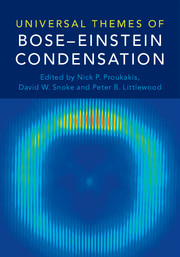Book contents
- Frontmatter
- Contents
- Foreword
- Preface
- Part I Introduction
- Part II General Topics
- Part III Condensates in Atomic Physics
- Part IV Condensates in Condensed Matter Physics
- Editorial Notes
- 19 Bose-Einstein Condensation of Photons and Grand-Canonical Condensate Fluctuations
- 20 Laser Operation and Bose-Einstein Condensation: Analogies and Differences
- 21 Vortices in Resonant Polariton Condensates in Semiconductor Microcavities
- 22 Optical Control of Polariton Condensates
- 23 Disorder, Synchronization, and Phase-locking in Nonequilibrium Bose-Einstein Condensates
- 24 Collective Topological Excitations in 1D Polariton Quantum Fluids
- 25 Microscopic Theory of Bose-Einstein Condensation of Magnons at Room Temperature
- 26 Spintronics and Magnon Bose-Einstein Condensation
- 27 Spin-Superfluidity and Spin-Current Mediated Nonlocal Transport
- 28 Bose-Einstein Condensation in Quantum Magnets
- Part V Condensates in Astrophysics and Cosmology
- Universal Bose-Einstein Condensation Workshop
- Contributors
- Index
- References
19 - Bose-Einstein Condensation of Photons and Grand-Canonical Condensate Fluctuations
from Part IV - Condensates in Condensed Matter Physics
Published online by Cambridge University Press: 18 May 2017
- Frontmatter
- Contents
- Foreword
- Preface
- Part I Introduction
- Part II General Topics
- Part III Condensates in Atomic Physics
- Part IV Condensates in Condensed Matter Physics
- Editorial Notes
- 19 Bose-Einstein Condensation of Photons and Grand-Canonical Condensate Fluctuations
- 20 Laser Operation and Bose-Einstein Condensation: Analogies and Differences
- 21 Vortices in Resonant Polariton Condensates in Semiconductor Microcavities
- 22 Optical Control of Polariton Condensates
- 23 Disorder, Synchronization, and Phase-locking in Nonequilibrium Bose-Einstein Condensates
- 24 Collective Topological Excitations in 1D Polariton Quantum Fluids
- 25 Microscopic Theory of Bose-Einstein Condensation of Magnons at Room Temperature
- 26 Spintronics and Magnon Bose-Einstein Condensation
- 27 Spin-Superfluidity and Spin-Current Mediated Nonlocal Transport
- 28 Bose-Einstein Condensation in Quantum Magnets
- Part V Condensates in Astrophysics and Cosmology
- Universal Bose-Einstein Condensation Workshop
- Contributors
- Index
- References
Summary
We review recent experiments on the Bose-Einstein condensation of photons in a dye-filled optical microresonator. The most well-known example of a photon gas, photons in blackbody radiation, does not show Bose-Einstein condensation. Instead of massively populating the cavity ground mode, photons vanish in the cavity walls when they are cooled down. The situation is different in an ultrashort optical cavity imprinting a low-frequency cutoff on the photon energy spectrum that is well above the thermal energy. The latter allows for a thermalization process in which both temperature and photon number can be tuned independently of each other or, correspondingly, for a nonvanishing photon chemical potential. We here describe experiments demonstrating the fluorescence-induced thermalization and Bose-Einstein condensation of a two-dimensional photon gas in the dye microcavity. Moreover, recent measurements on the photon statistics of the condensate, showing Bose-Einstein condensation in the grand-canonical ensemble limit, will be reviewed.
Introduction
Quantum statistical effects become relevant when a gas of particles is cooled, or its density is increased, to the point where the associated de Broglie wavepackets spatially overlap. For particles with integer spin (bosons), the phenomenon of Bose-Einstein condensation (BEC) then leads to macroscopic occupation of a single quantum state at finite temperatures [1]. Bose-Einstein condensation in the gaseous case was first achieved in 1995 by laser and subsequent evaporative cooling of a dilute cloud of alkali atoms [2, 3, 4], as detailed in Chapter 3 of this volume. The condensate atoms can be described by a macroscopic singleparticle wavefunction, similar to the case of liquid helium [1]. Bose-Einstein condensation has also been observed for exciton-polaritons, which are hybrid states of matter and light [5, 6, 7] (see Chapter 4), magnons [8] (see Chapter 25), and other physical systems. Other than material particles, photons usually do not show Bose-Einstein condensation [9]. In blackbody radiation, the most common Bose gas, photons at low temperature disappear, instead of condensing to a macroscopically occupied ground-state mode. In this system, photons have a vanishing chemical potential, meaning that the number of photons is determined by the available thermal energy and cannot be tuned independently from temperature.
- Type
- Chapter
- Information
- Universal Themes of Bose-Einstein Condensation , pp. 391 - 408Publisher: Cambridge University PressPrint publication year: 2017



